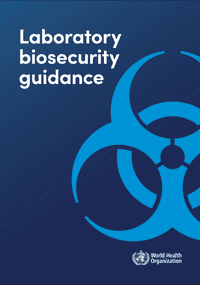Laboratory biosecurity guidance
[WHO Lab Biosecurity Guidance]
This laboratory biosecurity guidance pairs with the 4th edition of the LBM. It replaces the companion to the 3rd edition, titled "Biorisk management: laboratory biosecurity guidance". This guidance builds upon the biorisk management framework and focuses on principles and measures to prevent lapses and incidents throughout the whole value chain of handling high-consequence biological material, technology and information. This edition also expands on considerations for emerging technologies and potential threats, analyzes gaps in the current biosecurity system and proposes solutions.
SUMMARY
The World Health Organization (WHO) Laboratory biosecurity guidance was designed to help laboratory managers and national regulators strike a balance between traditional laboratory biosafety and broader laboratory biosecurity requirements. This version of the guidelines paris with the Laboratory Biosafety Manual 4th edition, updating a previous guidance released in 2006 that paired with the Laboratory Biosafety Manual 3rd edition. The guidance builds upon the biorisk management framework outlined in LBM 4th edition and focuses on principles and measures to prevent lapses and incidents throughout the whole value chain of handling high-consequence biological material, technology and information. This edition also expands on considerations for emerging technologies and potential threats. The target audience for the guidance is regulators, laboratory managers and laboratory personnel.
The guidance breaks down biorisk management into five key elements: 1) Consequence-driven biosecurity risk assessment; 2) Emerging technologies and potential threats (Cybersecurity, information security; molecular techniques, artificial intelligence); 3) International and national legislation/regulation, including a two-tier system of the national body and the institutions using a hybrid approach with risk-based elements of list-based high-consequence material; 4) Strengthening the role and responsibility of institutional biosafety committees; 5) Ultimate situations – war, civil unrest, devastating natural disasters


..png)
